How I Went from Climate Skeptic to Climate Doomer
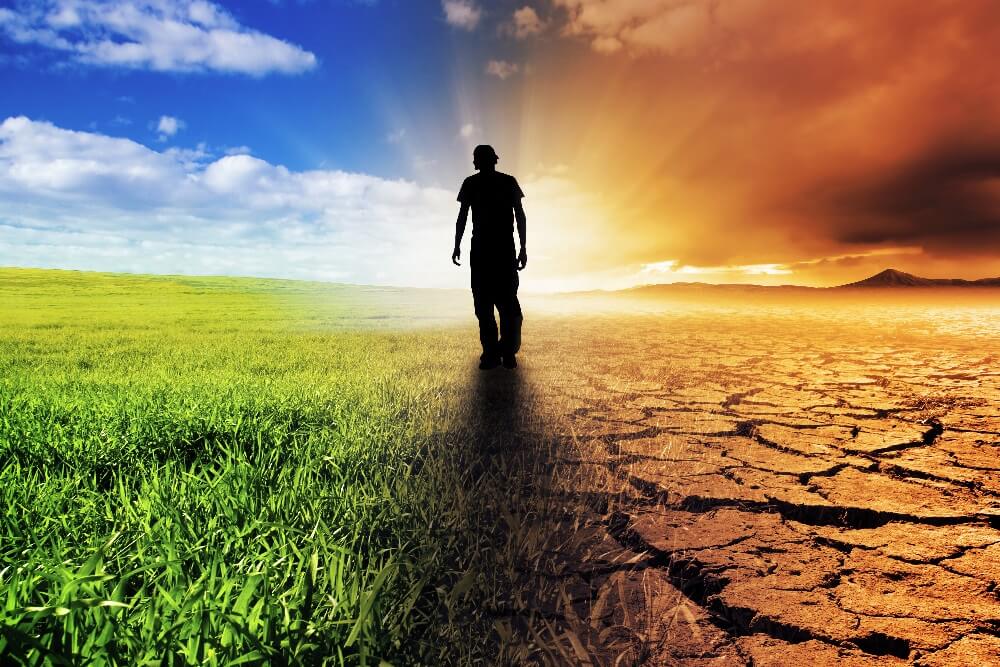
When I was in 4th grade, I had a teacher who was passionate about protecting the environment. She taught us how big and wondrous our planet is with all its plants, creatures, and ecosystems. She also taught us that our planet is in danger.
I remember her showing us before-and-after pictures of forests that had been clearcut. In one picture, I saw a lovely green canopy of trees extending for miles. In the next picture, I saw an ugly brown wasteland dotted with tree stumps. I had always loved forests, so I found these images disturbing.
My teacher told us that people were cutting down a dozen football fields’ worth of forest every single minute. I was shocked. I understood that we needed to cut down trees for wood and land, but did we have to cut down so many, so quickly? What if we ran out of trees?
Later that week, I told my dad what my teacher had said and shared my concerns.
He scoffed. “Your teacher is just trying to scare you,” he said. “Remember our road trip last summer? Remember how we drove for hours and hours and saw nothing but trees? Don’t worry. There are plenty of trees left.”
“Yea, but we can’t keep cutting them down forever. Eventually they’ll all be gone.”
Now he was annoyed. “That damn school. They’re trying to indoctrinate you with all that tree-hugger crap. Look, every time a logging company cuts down a tree, they plant a new one.”
“Really?”
“Of course. That way they can come back years later and cut those down. And then they’ll plant more trees. Your teacher didn’t tell you that, did she?”
“No.”
Then he told me the same thing my mom had told me earlier that year: “It’s a big planet, and there’s plenty of room. You don’t have to worry about the environment.”
From then on, my parents made sure to “de-indoctrinate” me every time I came home from school with knowledge about pollution, deforestation, global warming, or anything to do with saving the planet.
They were particularly against the idea of global warming, calling it a liberal conspiracy theory. My dad listened to Rush Limbaugh almost every day, and he told me that the government wanted to use global warming as an excuse to take away our rights, reduce our standard of living, and control our lives.
At that age, I barely understood what the government was or how it worked, so I just took his word for it. Although he was clearly wrong about environmental issues, my dad was intelligent and wise (about most things), so I continued to believe him throughout my school years.
Whenever a teacher said something about climate change or the environment, I rolled my eyes and tuned out. Whenever I saw pollution or recycling mentioned on TV, I grumbled to myself about how dumb it was.
I maintained this attitude well into my adulthood. When Al Gore released An Inconvenient Truth, I rambled to my drinking buddies about how stupid it was and how Al Gore was part of a vast global conspiracy. Of course, I didn’t bother to actually watch the movie. Why would I when I already knew it was BS?
“The climate has always changed,” I told my friends. “And look how cold this winter has been. So much for global warming.” I’m ashamed to say that I used every climate-denier cliché in the book.
Although I believed that liberals wanted to use the environment as an excuse to create a socialist dictatorship, I wasn’t too worried about it. It had been nearly 20 years since my dad first told me about the liberal conspiracy, and they hadn’t made much progress. The president was a Republican, and we still had all the same rights we did when I was a child.
I didn’t start worrying until the 2008 Democratic primary. Bush’s approval rating was in the toilet, and it looked like the next president was going to be Hillary Clinton or Barack Obama, both of whom terrified me.
I was particularly worried about Obama’s cap-and-trade program. It sounded exactly like the sort of thing my parents had warned me about as a child. Obama wanted to jack up the cost of energy, reduce our standard of living, and make us dependent on the government.
Now, I wanted to learn all about climate change so I could prove it wrong. At this point, I barely understood the greenhouse effect, so I had a long way to go.
Of course, I got a lot of false information from sketchy blogs and forums filled with armchair climate scientists. But I also spent a lot of time looking at info from NASA, the IPCC, and well-respected journals like Nature.
Over the next few years, I slowly began to change my mind about climate change. I didn’t want to believe it was real, but I found myself unable to disprove the following facts:
- Greenhouse gases raise temperatures.
- The amount of greenhouse gases in the atmosphere is rising fast.
- Average global temperatures are rising fast.
- Humans are emitting huge amounts of greenhouse gases.
No matter how hard I tried, I just couldn’t disprove these facts. There were mountains of data and studies backing them up. And every time I thought I found an article disproving one of them, it always turned out the author was cherry-picking data or misrepresenting it.
I still hated Al Gore, Barack Obama, and the liberal elite, but by my mid-thirties, I reluctantly admitted that they were right. Climate change was real, and it was already changing weather patterns. (I explain my transition and the 4 facts above in more detail in this article.)
This is the part of the story where I’m supposed to tell you how I became a climate activist, how I vastly reduced by carbon footprint, and how I started warning my friends and family about global warming.
But that’s not what I did. In fact, I didn’t do anything. Although I was now convinced that climate change was real, I still wasn’t worried about it.
Why? Because all my life I had been taught that the elites — Bill Gates, George Soros, and all the other men in smoke-filled back rooms — were working hard to stop climate change. So, I assumed they had it under control.
Around that time, wind and solar power were getting a lot cheaper, electric vehicle technology was making huge leaps forward, and governments around the world were encouraging companies to use carbon credits to offset their emissions.
Then in 2015, nearly every nation on Earth signed the Paris Agreement, an international treaty to reduce greenhouse gas emissions and limit global warming to 2°C at the very most, and preferably 1.5°C. This only confirmed my belief that government and corporate elites were taking the necessary steps to avert a climate catastrophe.
After all, governments and corporations had a vested interest in stopping climate change. Governments would struggle to maintain law and order if climate disasters got too severe, and corporations would struggle to earn profits if their customers were starving to death. So of course they would try to stop climate change…right?
A year later, Donald Trump — a man who called climate change a Chinese hoax — was elected president. Within the first few months of his presidency, he gutted the EPA, rolled back all sorts of environmental regulations, and withdrew the United States from the Paris Climate Agreement.
Around this time, I began to realize that the global elites did not have climate change under control. Not even a little. If they did, they wouldn’t have let Donald Trump become president, and they wouldn’t have let the U.S. withdraw from the Paris Agreement.
Still, I had hope that most governments and businesses would start reducing emissions on their own. I just couldn’t believe that global leaders would be willing destroy the environment knowing it would bring their own countries to ruin.
Over the next year or two, I began to see some disturbing articles. The UN warned that the goals set out in the Paris Agreement weren’t enough to stop severe warming, and even if they were, countries weren’t meeting their climate goals, anyway.
Around that time, the IPCC released a special report which warned that we had 12 years left to prevent the worst effects of climate change. The authors said that to limit global warming to moderate levels, we would need to make massive changes to our global energy infrastructure by 2030 at the very latest.
At first, this news terrified me, but then I began to feel hopeful again. Maybe now that the IPCC had set a firm deadline, countries would finally start taking their warnings seriously. And maybe if we voted Trump out of office, the next President would be wise enough to declare war on climate change and mobilize the country in a way not seen since World War II.
I got even more optimistic in January of 2020, when Bernie Sanders became the frontrunner in the Democratic primary. I never imagined that someone as radical as him would have a shot at becoming president, but he seemed unstoppable. Maybe Sanders would change the course of history, just as FDR did with the New Deal.
On February 29th, Biden won the South Carolina primary by a huge margin. Suddenly, all the other candidates were dropping out and endorsing him, and the mainstream media spent days convincing everyone that Biden was their only option. Then on Super Tuesday, Biden won big in several states and became the new frontrunner.
Although Biden had called climate change an “existential threat,” I doubted he would take the steps necessary to prevent climate catastrophe. Still, I kept searching for hope. I wanted to find something — anything — that suggested we could avoid the worst case scenario.
One day, I came across a graph that made my stomach sink: the Keeling Curve. This famous graph shows the accumulation of CO2 in the atmosphere over time, going from less than 320 ppm to nearly 420 ppm in just 60 years.
I had seen this graph before, but now I was seeing it with a fresh perspective. You see, at this point I knew about the first UN Climate Change Conference in 1995, the Kyoto Protocol in 2005, the Copenhagen Accord in 2009, and of course the Paris Agreement in 2015 — not to mention COP (Conference of Parties), which had been meeting every year since the mid 90s.
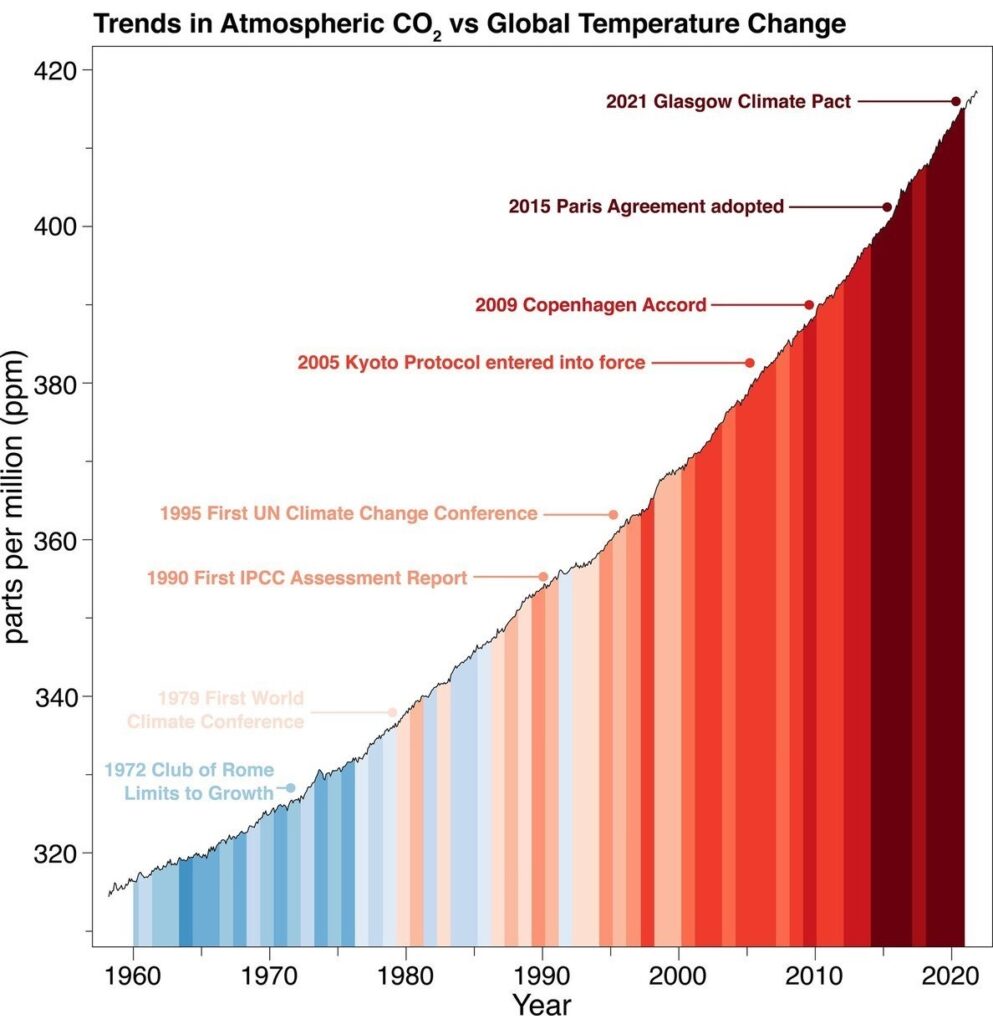
Now, looking at the Keeling Curve, I realized that all the meetings, conferences, protocols, accords, and agreements were having no effect on the rise in CO2 emissions. None. Nada. Zilch. Zero. All these pledges and treaties were completely useless. So why did countries keep making them?
And that’s when it hit me: These meetings weren’t about stopping climate change; they were about leaders convincing themselves and the public that they were stopping climate change. Kinda like a smoker who says, “Yea, I’m gonna quit, and I’ve already cut back a little, I just need some time to adjust, but don’t worry, I’m definitely quitting, and long before I get cancer, you’ll see…”
I finally understood the horrible truth: We were not going to stop a climate catastrophe. Countries were going to continue with business-as-usual for as long as possible while telling themselves that everything would somehow turn out okay.
So now, I only had one question: How bad would climate change get?
One day, I got my answer when I came across an article by David Wallace-Wells called The Uninhabitable Earth. This article scared the hell out of me. Until then, whenever I thought of climate change, I thought of rising sea levels, powerful hurricanes, and megadroughts. But now I knew that those things were merely the tip of the melting iceberg.
In his article, David explained exactly what we’re in for in the coming decades: heat waves so intense that thousands of people drop dead, widespread crop failures leading to global famine, pandemics even worse than the Spanish flu, perpetual wars over food and water, and permanent economic collapse.
I finally understood that climate change wasn’t something we could learn to live with. If we didn’t stop global warming immediately, it would bring about the end of modern civilization.
For the first time, I wasn’t just worried about climate change; I was scared. Terrified.
But the terror didn’t last for long. Humans can’t function in a constant state of terror, and my brain worked hard to convince me that things couldn’t possibly be as bad as David Wallace-Wells claimed.
The next morning, I woke up feeling a lot better. The article I had read the previous day was like a slowly-fading dream, and I remembered that there were lots of climate experts who didn’t think societal collapse was inevitable. I decided that I should stop worrying and get on with my life.
This is a common reaction among people who become collapse-aware. When you see the end of the world on the horizon, it’s natural to turn back and run in the opposite direction. But once you’ve seen the end, you can’t unsee it. And no matter how fast you run away, every time you look over your shoulder, it seems to get even closer.
That was my experience in the following months. I kept looking for evidence that things weren’t as bad as I feared, but the more I learned, the worse it looked.
I learned that global warming wasn’t happening linearly, but exponentially. It took us 150 years to raise the global temperature by 1°C, and yet scientists said we might raise it another degree in as little as 30 years.
At 1°C, we were already seeing record-breaking droughts, heatwaves, wildfires, floods, and other extreme weather events. So how bad would the weather be at 2 degrees of warming? Or 3? Or 4? It was hard to imagine.
Already at 1 degree of global warming…
- Arctic sea ice was rapidly declining, heading inexorably toward a blue ocean event, after which the Arctic would warm up even faster.
- The Greenland and Antarctic ice sheets were melting faster ever year, raising sea levels and disrupting important ocean circulation patterns.
- Droughts and heatwaves were getting longer and more severe, sparking record-breaking wildfires all around the world.
- Farmers were relying on groundwater to water their crops — groundwater that was rapidly being depleted.
- Floods were getting bigger, destroying crops and displacing millions of people.
- Extreme weather was creating millions of new migrants every year, and the UN said there could be a billion by 2050.
- Biodiversity was collapsing, with insect populations rapidly declining, and marine life headed toward total extinction in a matter of decades.
All of that…with just 1 degree of warming. And I was supposed to believe that civilization could survive with 2 degrees of warming?
For a short while, I hoped that maybe technology would halt global warming. The IPCC was apparently convinced that we would simply suck all the billions of tons of CO2 out of the atmosphere and store it underground.
Unfortunately, I couldn’t find any evidence that carbon capture technology would be able to scale up quickly enough to stop climate breakdown. The first carbon-capture plant only collected about 900 tons of carbon out of the 37 billion tons of CO2 emitted each year. Whoop-de-do. Now we only need another 40 million plants.
I thought maybe we would switch to renewables like solar panels and wind turbines. Unlike carbon capture technology, renewables really were advancing at a rapid rate, so perhaps a green energy revolution would save us.
But then, I learned that there likely weren’t enough rare-earth metals for a green energy revolution, anyway. And even if there were, it wouldn’t stop emissions from industry and agriculture, which together cause nearly half of global emissions.
And even if we came up with some magical source of clean energy like fusion power, we would still need fossil fuels to create things like steel, plastic, and concrete. And we would still need natural gas to create fertilizer, without which half the world would starve.
I soon learned that it’s even worse than that. Even if we had a source of free energy and free food and we stopped emitting greenhouse gases completely, the planet would temporarily warm up even faster. Seriously.
The aerosols in the air have been masking about half of global warming. That means if we stopped burning fossil fuels and allowed the aerosols in the air to dissipate, the average global temperature would jump another 0.5°C in a matter of years.
And if that happened, we would likely trigger several tipping points. The permafrost would melt, releasing huge quantities of methane. And the Amazon would burn, releasing countless tons of CO2.
It seemed that even in the best-case scenario, we would likely trigger enough tipping points for global warming to continue on its own, without our help. But I knew that the best-case scenario would never happen, anyway. It would require every major world leader declaring an end to economic growth and shepherding their populations through a controlled economic decline (also known as degrowth) that would wipe out the middle class.
Was there ever any chance of that happening? Of course not. There wasn’t a single world leader talking about degrowth. Even Bernie Sanders wasn’t talking about it.
So that’s how I became a climate doomer. I realized that we are so deep in the hole that it’s virtually impossible to get back out. And even if it were possible, there is no way to convince billions of people to accept a vastly reduced standard of living, especially since many of them don’t even believe in climate change.
Since I became a climate doomer back in 2020, things have gotten much, much worse. The world just temporarily crossed the 1.5°C threshold, emissions are rising as fast as ever, and some climate scientists believe there’s as much as 10°C of warming in the pipeline if we don’t quickly find a way to suck a century of emissions out of the atmosphere.
Meanwhile, the world is rapidly running out of freshwater, droughts and heatwaves are causing problems for farmers, and somehow we’re supposed to increase food production by 70% over the next few decades to feed a growing population. Never gonna happen.
Once the agricultural system can’t produce enough food to feed everyone, countries will descend into chaos and go to war with one another over resources. The chance of nuclear armageddon will skyrocket.
How long until all this happens? Maybe a few years, maybe a couple decades at most.
I’m not saying we should just give up. The less damage we do to the planet, the fewer people will die, and the more species we will save. So don’t get me wrong. Climate action is more important than ever.
But if your goal is to save our current civilization, then I have bad news for you: It can’t be saved. Instead, our goals should be to keep as many fossil fuels in the ground as possible and to start planting the seeds a new, sustainable society in the future.
It amazes me that there are still some climate scientists who aren’t doomers. I think the reality that our entire civilization is going down the drain in our lifetime — that they along with their friends and family will probably die a terrible death — is so horrifying that they just can’t accept it. They have to believe that there is still hope, otherwise they would have to start the process of grieving, and that’s no fun.
But I promise you this: The sooner you accept the reality of our predicament and start working through the stages of grief, the faster you will reach the stage of acceptance and start living your life to the fullest. Like a cancer patient with a terminal diagnosis, you’ll start learning how to let go of petty concerns and focus on what truly matters.
We can’t stop the collapse, but we can still choose what to do with the time we have left.
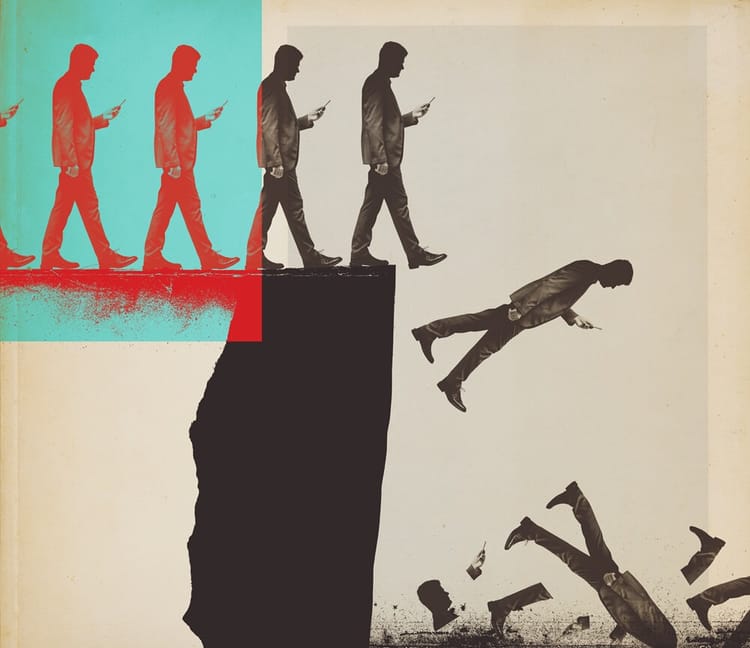
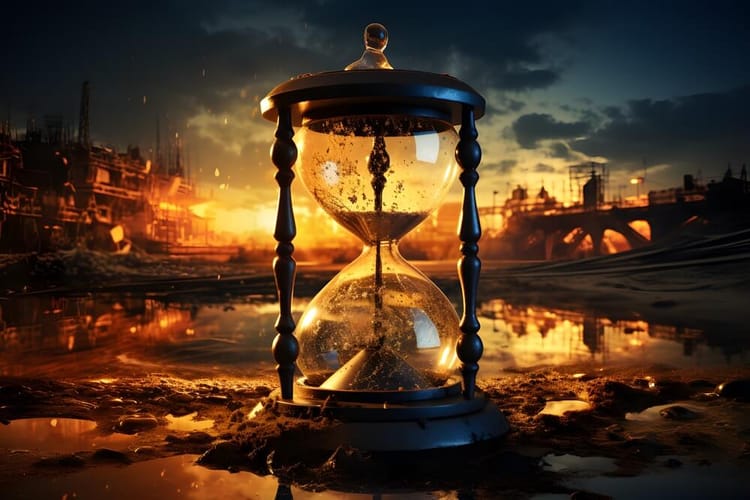
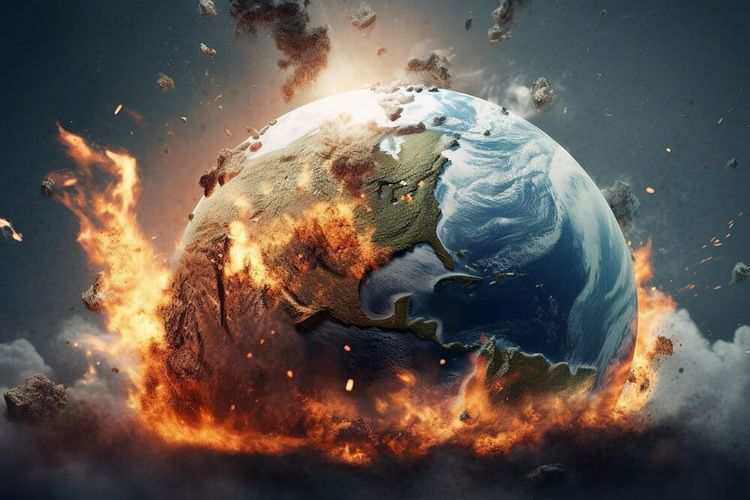
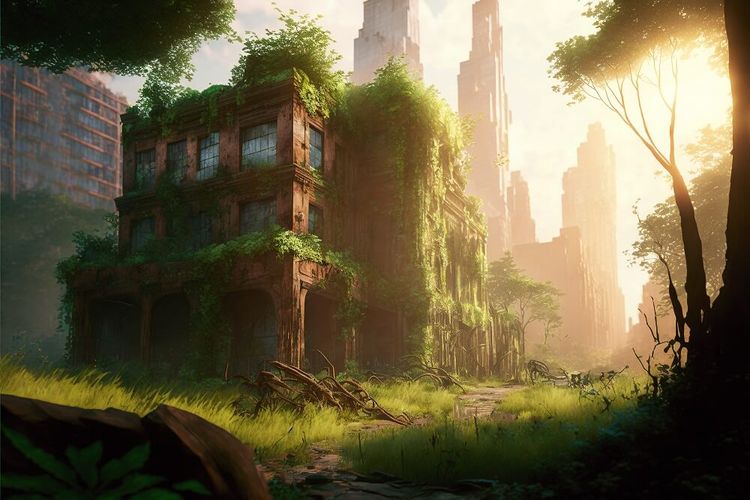
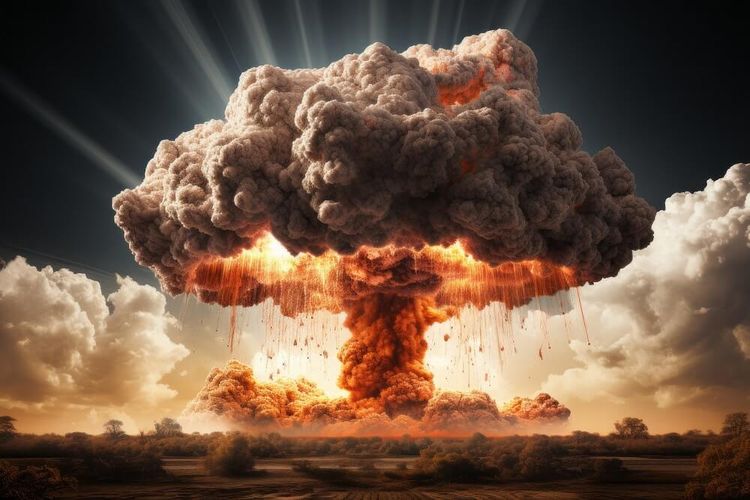
Member discussion